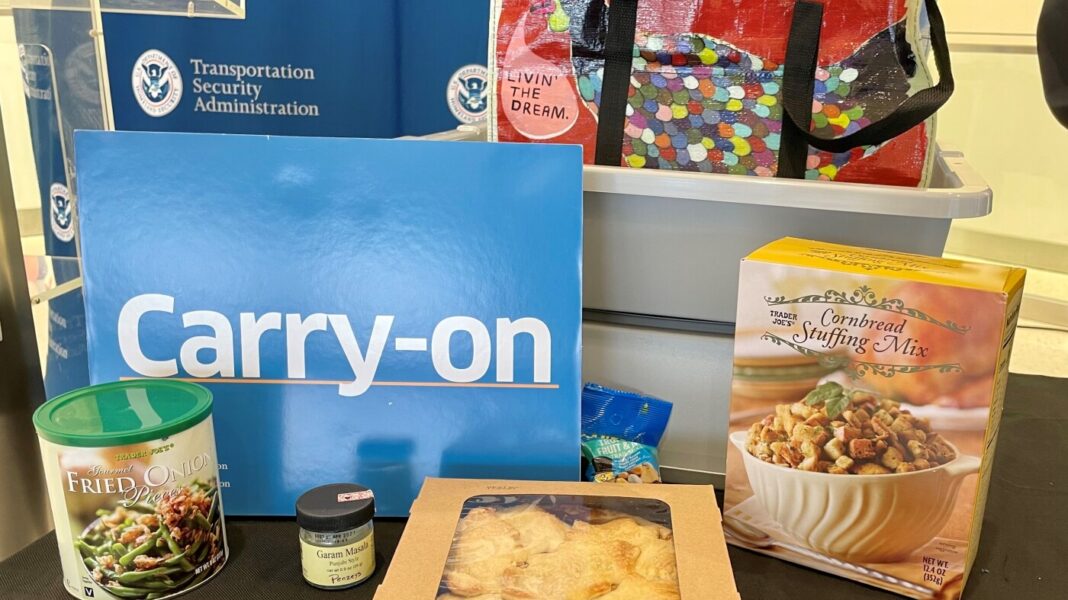
The Transportation Security Administration has listed Thanksgiving foods that can be carried through a TSA checkpoint.
Transportation Security Administration
hide caption
toggle caption
Transportation Security Administration
Did your friends ask you to bring some cranberry sauce to Thanksgiving dinner? Thinking about bringing home dad’s famous mac and cheese that has the secret ingredient that makes it melt in your mouth? Or how about your mother-in-law’s candied yams that have been a family favorite each year for over a decade?
That shouldn’t be an issue if you’re flying, according to the Transportation Security Administration. The agency says most foods can be brought through TSA checkpoints while others will need to go through a checked bag.
Traveling by train? That shouldn’t be a problem. Amtrak allows riders to bring their own food and drinks onboard at their seats or private sleeping car. However, you can only eat food and drinks bought in the dining and lounge cars while in those cars.
Here is what you need to know about traveling home with your favorite Thanksgiving dishes.
What you should carry on the plane and check with your luggage
The following items can be taken through a TSA checkpoint:
- Cooked mac and cheese in a pan.
- Cooked or uncooked stuffing in a bag or box.
- Sweet treats and baked goods such as homemade or store brand cakes, pies and cookies.
- Green bean casseroles and other types of casseroles.
- Yams, potatoes, green beans, squash and other types of fresh vegetables.
- Chicken, ham, turkey and steak, which can be frozen, cooked or uncooked.
Foods that TSA says should be packed with your checked luggage include sparkling cider, cranberry sauce (homemade or canned), maple syrup and gravy (homemade or in a can or jar).
And if you plan to take your food on the plane as a carry-on, make sure your dishes that have liquid meet TSA’s 3-1-1 rule, which mandates that it must be 3.4 ounces or less, fit into 1 quart-sized bag and it is one bag per passenger.
When in doubt, TSA says to consider this: “If it’s a solid item, then it can go through a checkpoint. However, if you can spill it, spread it, spray it, pump it or pour it, and it’s larger than 3.4 ounces, then it should go in a checked bag.”
TSA Administrator David Pekoske said flyers can also double-check on the agency’s website if the food they bring can go through a checkpoint.
“There is a special tag for ‘what can I bring.’ And you can put what you want to bring into the search feature and it will tell you whether you can bring it in your accessible property through the checkpoint or whether you can bring it in your checked baggage,” he said during a press conference Thursday.
Fliers can also text “Travel” to AskTSA (275-872) and get an answer regarding their holiday dish, he said.
Make sure you can keep it at the right temperature
Your grandma’s green bean casserole won’t be any good to you if it doesn’t stay preserved at the right temperature or spoils.
Leftovers must be refrigerated within two hours of being served or kept hot at or above 140 degrees or cold below 40 degrees in order to be safe and prevent food poisoning, the U.S. Department of Agriculture says. USDA advises to throw away food that’s been out more than two hours at room temperature because “bacteria that cause foodborne illness could have reached dangerous levels.” The agency also suggests cutting leftover turkey into small pieces and putting them in shallow containers so it can cool faster and evenly.
If you want to chow down on some deviled eggs during a long flight, layover or train stop, you might want to reconsider and wait until you get to your destination. The Centers for Disease Control and Prevention says all leftovers should be reheated to at least 165 degrees before eating.
Amtrak staff are also prohibited from heating your food in their ovens, handling it or storing it in their refrigerators.
TSA allows ice packs as long as they are frozen solid and not melted when going through a screening checkpoint. Frozen ice and ice packs must also meet TSA’s 3-1-1 rules.
Be considerate of others traveling with you
While the smell of the food you share among your family and friends may make your mouth water, foods such as deviled eggs and chitterlings may not be as aromatic for others.
According to a YouGov survey released in June, 68% of U.S. adults say it’s unacceptable to eat strong-smelling food while on an airplane.
“If … somebody comes in with smelly, greasy food and that’s unpleasant to the person sitting next to him, or the person sitting next to him is uncomfortable watching them chow down, that’s a problem,” Scott McCartney, former Middle Seat columnist for The Wall Street Journal, previously told NPR.
Keep that in mind while sitting next to someone on the plane and you want to open up that container of collard greens before takeoff.
NPR’s Joel Rose contributed to this report.




